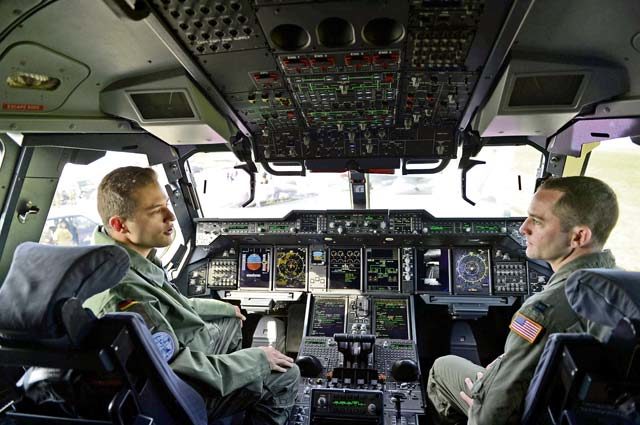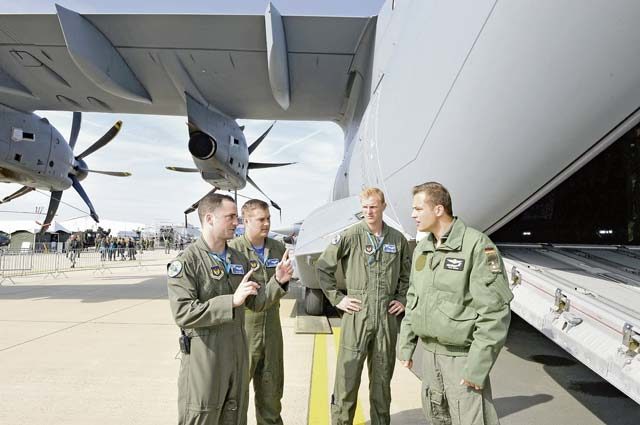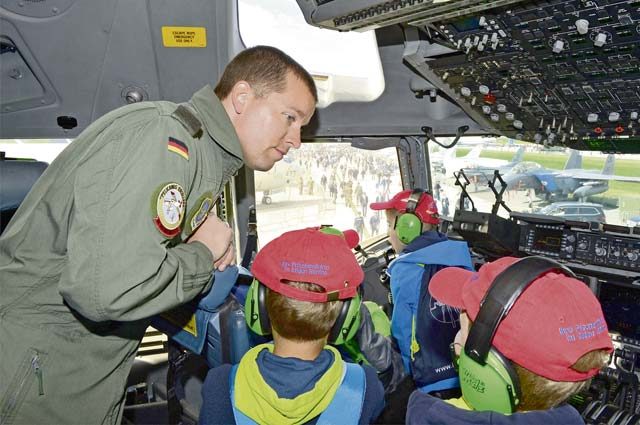
BERLIN, Germany — When boarding U.S. aircraft during an air show, it is natural for people to expect a U.S. pilot or crew member to greet them.
This wasn’t the case when a group of German school children visited a C-17 Globemaster III during the Berlin Air and Trade Show on April 27. Instead, they were greeted by a German pilot assigned to Joint Base Charleston, S.C., as part of the Military Personnel Exchange program.
“They’re so fascinated by the aircraft and helicopters at this air show,” said Maj. Rico Persy, German air force pilot. “It feels good to get the chance to have classes on board and show them the aircraft. They’re super excited about being here.”
Persy added that he is confident the experiences of the children at the air show, such as visiting the aircraft and seeing one of their own countrymen serving with the U.S., will leave a lasting impression on them and perhaps inspire them to serve as well.
The 2018 Berlin Air and Trade Show fell under the same year as the 70th anniversary of the Berlin Airlift, in which U.S. and allied forces airlifted supplies into West Berlin following a Soviet blockade of the city.
The C-17 that Persy commanded during the air show, nicknamed “The Spirit of Berlin,” commemorates the airlift. The Berlin Airlift demonstrated the U.S. commitment to its allies, and signified the reliability of the alliance in desperate times.
Persy said that although he serves as a foreign exchange pilot, he feels completely at one with his U.S. teammates.
“It’s a once-in-a-lifetime experience for me, and I’m thankful for that,” he said. “I don’t feel like I’m any different or someone special. I’m just like any pilot in the squadron—just like anybody else.”
Elsewhere during the air show, U.S. Airmen from the 37th Airlift Wing met with their German counterparts from the Air Transport Wing 62, or “Lufttransportgeschwader 62.” The air show gave the two partnership wings the opportunity to socialize and exchange information about their respective aircraft: the C-130J Super Hercules and A400M Atlas.

Capt. Tim Vedra, 37th AS C-130J instructor pilot said that it is important for allies to understand each other’s equipment in order to execute combined missions smoothly.
“It’s really cool to see some of the different things the A400M has,” he said. “If we ever flew together in a formation, we would have a better understanding of what they are able to do.”
1st Lt. Felix, an A400M co-pilot, said he was also impressed by the versatility of the C-130J. He expressed desire to see the A400M and C-130J to fly together in a mission.
“It is a very good thing to exchange knowledge and experience and learn from each other,” he said. “I think we can do a lot of missions together anywhere in the world very successfully.”
Loadmasters from both aircraft also shared their capabilities.
Master Sgt. Martin, an A400M loadmaster, said that while different nations have different aircraft, there are many similarities between the duty descriptions of the aircrew.
“Many things are pretty similar with the job we are doing,” he said. “It’s really nice to see that many other guys from different nations are doing the same job, and they know what we are talking about.”
Martin added that exchanging ideas between allies can benefit both parties involved. If loadmasters from a certain airframe see crewmembers from a different aircraft use techniques which work for them, the former might be able to incorporate those techniques into their own and vice versa, Martin said.
Overall, Martin expressed his enjoyment of being a loadmaster and the connection he feels with his colleagues from other nations.
“It’s a fantastic feeling to sit in the aircraft, fly around the world, and do jobs that you couldn’t in the office,” he said. “Our office is the sky.”



